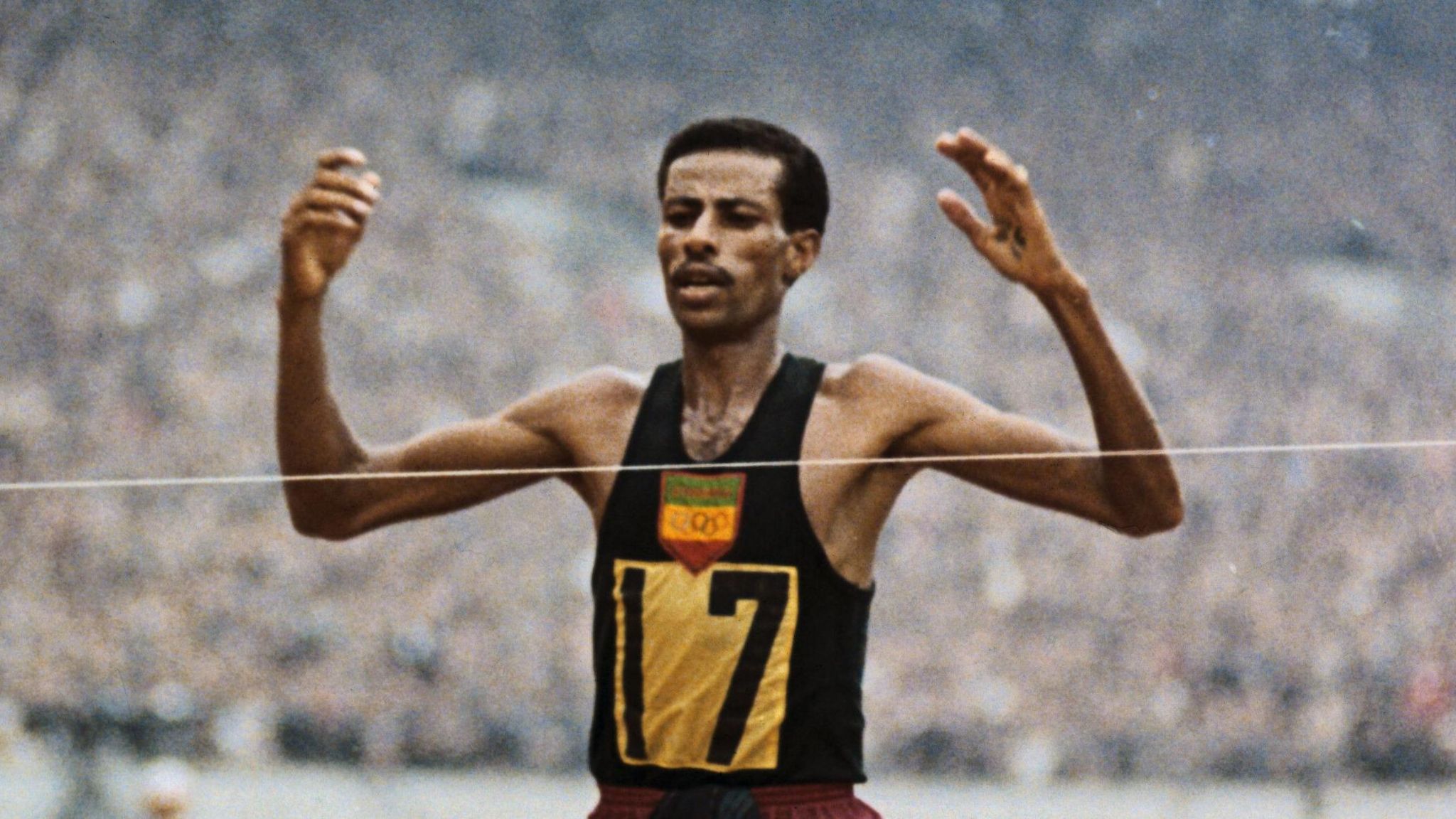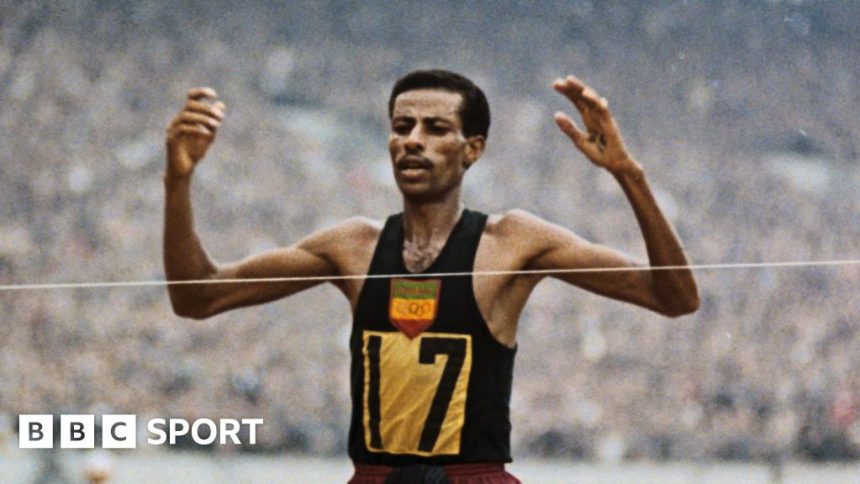Who was Africa’s first black Olympic gold medallist?

Abebe Bikila’s two marathon wins began a gold rush for African distance runners who now dominate at the Olympics
-
Published
In 1960, on a warm night in Rome, a barefoot son of a shepherd stunned the world and made history for Africa.
That evening, the streets of the city were lined with spectators cheering for the marathon runners competing in the Olympic Games.
Alongside the road, Italian soldiers held torches to light the way as an Ethiopian runner named Abebe Bikila sprinted towards the finish line.
For most of the course, Bikila, in red satin shorts and a black vest, had been level with the marathon favourite, Rhadi Ben Abdesselem from Morocco.
Then, with less than a mile to go, he began to pull away from his competitor. He sprinted towards the finish, raising his hands in triumph as he crossed the line.
Not only had he come first in the race, Bikila was also the first black African and the first Ethiopian to win a gold medal at the Games.
In doing so, he set a new world record of two hours, 15 minutes and 16 seconds.
It was a shock triumph, not only because Bikila was a complete unknown, but because he had run the entire length of the race barefoot.
Bikila had made the decision to do so because his running shoes were worn, and he feared using a new pair would cause blisters.
“Normally champions rise up the rankings and so when they get to the top they are known, but Bikila was utterly unknown,” says Tim Judah, a British writer who has written a book about the runner.
“So this compounded the shock of a barefoot African winning the marathon.”
Bikila ran all 26 miles and 385 yards barefoot across Rome’s cobblestone streets
Bikila returned home a national hero, greeted by thousands.
However, his 1960 victory bore significance beyond his home nation.
“This was the period of decolonisation and the arrival of Africa on the world stage,” says Judah.
“In that sense he was like a shooting star of hope and a symbol of the era.”
The symbolism of Bikila’s win continues to this today.
“If you look what happened to Africa, independence started after Abebe Bikila won in Rome,” says the former Olympic and World Champion Ethiopian distance runner, Haile Gebrselassie.
When Bikila returned to his home country, the Kenyan newspaper, Nation, reported that Emperor Haile Selassie awarded him the Star of Ethiopia. He also promoted him to the rank of corporal, gave him a house and new Volkswagen Beetle.
Humble beginnings
Bikila’s upbringing was far from the glamour of his Olympic triumph.
He was born in 1932 in the rural Ethiopian village of Jato, the son of a shepherd.
As a young man, after moving to the capital Addis Ababa, he joined the nation’s Imperial Guard where he was given the prestigious role of protecting then Emperor Haile Selassie.
It was here that his athletic talent was spotted by the Swedish coach, Onni Niskanen, who had been employed by the Ethiopian government to train soldiers.
Niskanen began training Bikila to compete in the marathon.
However, Bikila was not considered Ethiopia’s best runner. His teammate, Wami Biratu, was favoured for the Rome Games, but just days before their departure, Biratu fell ill, and had to stay behind.
Bikila’s win in Tokyo in 1964 made him the first marathon runner to defend an Olympic title
A second Olympic gold medal
Bikila’s legacy was cemented at the 1964 Tokyo Olympics, where he defended his marathon title, becoming the first person to win back-to-back gold medals in the event.
To this day, Bikila remains one of only three runners, alongside Waldemar Cierpinski and Eliud Kipchoge, to have done so.
This time the runner wore shoes. But he had another challenge to overcome.
Just 40 days before the event, Bikila had undergone an emergency operation to remove his appendix.
Despite only having weeks to return to full health, he sprinted down the running track in Tokyo’s national stadium to set another world record of two hours, 12 minutes and 11 seconds.
According to World Athletics, Bikila won 12 out of 13 international marathons between 1960 and 1966. But just five years after his second Olympic win, tragedy struck.
Aside from archery, Bikila also tried his hand at table tennis and sleigh-riding
Overcoming adversity
In March 1969, reportedly while at the wheel of his Volkswagen Beetle, Bikila was involved in a car accident that paralysed him from the neck down.
He was flown to the specialised spinal injuries unit at Stoke Mandeville Hospital in England for treatment and had to accept that he would never walk again.
But the runner was able to regain control of his hands, and so he turned to other sports – excelling in archery and table tennis.
In 1970, he participated in the Stoke Mandeville Games in London, an early precursor to the Paralympics.
The following year, he competed in Norway, where he won the cross-country sleigh-riding event at a competition for disabled athletes.
To this day, Abebe Bikila’s story continues to inspire athletes
A legacy that lives on
In 1973, Bikila passed away at the age of 41, due to complications from his accident.
Emperor Haile Selassie declared a National Day of Mourning and Bikila was given a state funeral.
But despite his early death, the runner’s legacy continues. There is an Abebe Bikila stadium in Addis Ababa and many schools and awards bear his name.
Bikila’s biggest legacy has been to inspire a new generation of long-distance runners across East Africa who have followed in his footsteps.
A number of Ethiopian and Kenyan athletes, such as Haile Gebrselassie and Eliud Kipchoge, have gone on to dominate the sport.
“We [African runners] are the result of Abebe Bikila. Because of Abebe Bikila, I became a world class athlete,” says Gebrselassie.
Getnet Wale, who will represent Ethiopia at the Paris Olympics in the 3000m steeplechase, has described Bikila as a “trailblazer”.
“He was the first. He’s always remembered till this day.”






